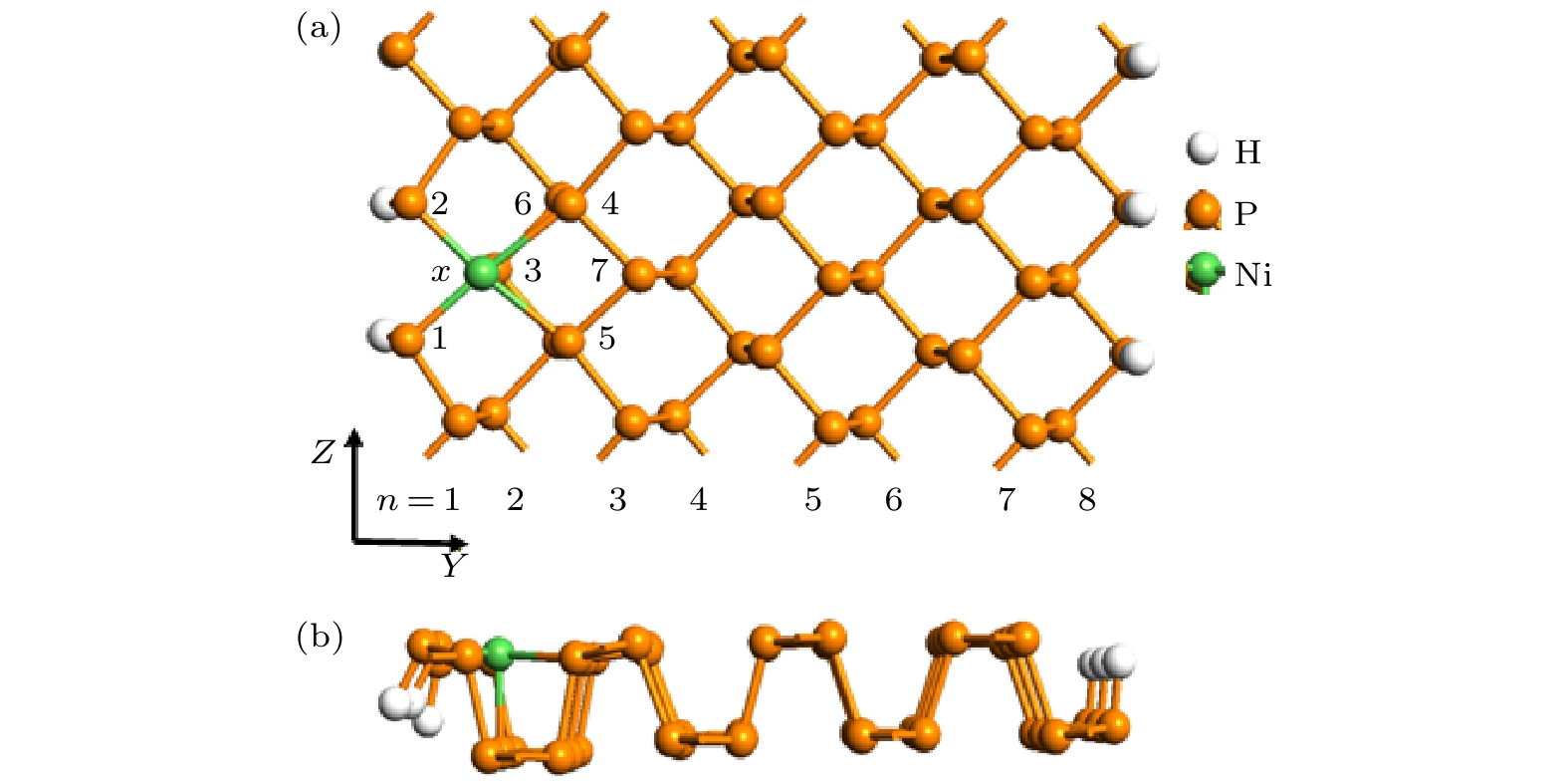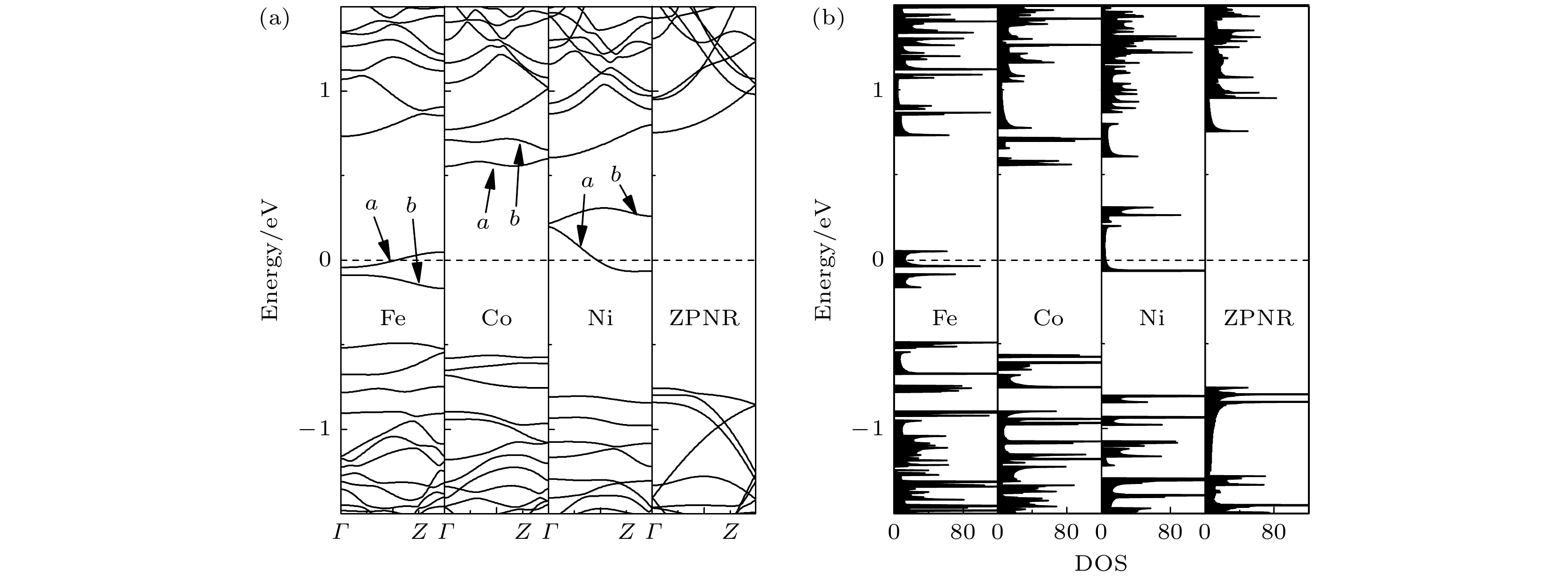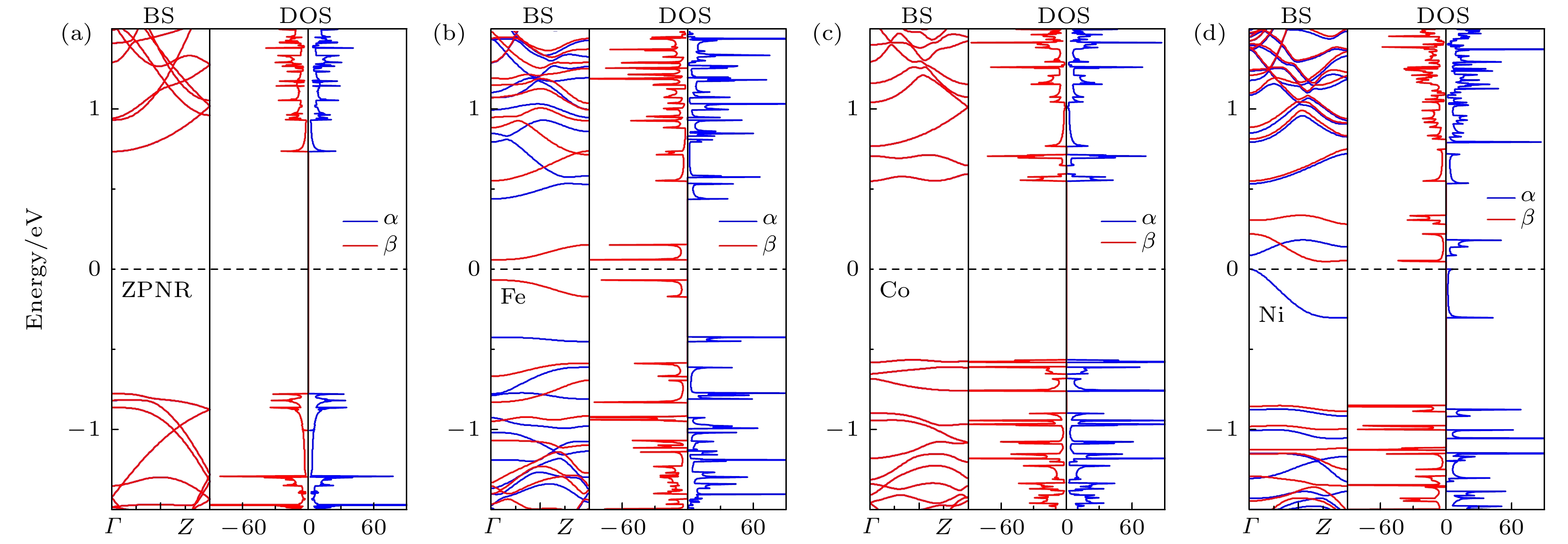-
利用基于密度泛函理论的第一性原理方法, 研究了掺杂铁、钴和镍原子的锯齿型磷烯纳米带(ZPNR)的磁电子学特性. 研究表明, 掺杂和未掺杂ZPNR的结构都是稳定的. 当处于非磁态时, 未掺杂和掺杂钴原子的ZPNR为半导体, 而掺杂铁或者镍原子的ZPNR为金属. 自旋极化计算表明, 未掺杂和掺杂钴原子的ZPNR无磁性, 而掺杂铁或者镍原子的ZPNR有磁性, 但只能表现出铁磁性. 处于铁磁态时, 掺杂铁原子的ZPNR为磁性半导体, 而掺杂镍原子的ZPNR为磁性半金属. 掺杂铁或者镍原子的ZPNR的磁性主要由杂质原子贡献, 产生磁性的原因则是在ZPNR中存在未配对电子. 掺杂位置对ZPNR的磁电子学特性有一定的影响. 该研究对于发展基于磷烯纳米带的纳米电子器件具有重要意义.The magneto-electronic properties of zigzag phosphorene nanoribbons (ZPNRs) doped, respectively, with iron (Fe), cobalt (Co) and nickel (Ni) atoms are investigated by the first-principles method based on density functional theory. The calculated results show that the structures of doped and undoped ZPNR are stable because their binding energy and Gibbs free energy are negative, and the Forcite annealing dynamics simulation shows that the thermal stabilities of all doped ZPNRs are extremely high. The ground states of pristine ZPNRs and ZPNRs doped with Co atoms are nonmagnetic states, while the ground states of ZPNRs doped with Fe or Ni atoms are ferromagnetic states. When they are in the nonmagnetic states, the pristine ZPNRs and ZPNRs doped with Co atoms turn into semiconductors, while the ZPNRs doped with Fe or Ni atoms become metals. The undoped ZPNRs are direct band gap semiconductors, while the ZPNRs doped with Co atoms are indirect band gap semiconductors, and the band gaps of the latter are smaller than those of the former. The changes of the properties of the ZPNRs are due to the introduction of impurity energy band into the energy band structures. The spin-polarized calculation displays that the pristine ZPNRs and ZPNRs doped with Co atoms are non-magnetic, and the ZPNRs doped with Fe or Ni atoms are magnetic but only in the ferromagnetic state. In the ferromagnetic state, the ZPNRs doped with Fe atoms are spin semiconductors, while the ZPNR doped with Ni atoms are spin half-metals. This means that the half-metal feature can be realized by doping Ni atom into ZPNR. The magnetism of ZPNRs doped with Fe or Ni atoms is mainly contributed by impurity atoms, and the occurrence of magnetism is due to the existence of unpaired electrons in ZPNR. The doping position has a certain influence on the electromagnetic properties of ZPNR. In the ferromagnetic state, the ZPNRs are half-metals when the Ni atoms are doped near the edge of the nanoribbons, while the ZPNRs are spin semiconductors as the Ni atoms are doped near the symmetric center of the nanoribbons. These results might be of significance for developing the phosphorene based electronic nanodevices
-
Keywords:
- phosphorene nanoribbon /
- doping /
- electronic property /
- magnetic property
[1] Reich E S 2014 Nature 506 19
 Google Scholar
Google Scholar
[2] Liu H, Neal A T, Zhu Z, Luo Z, Xu X F, Tomanek D, Ye P D 2014 ACS Nano 8 4033
 Google Scholar
Google Scholar
[3] Rodin A S, Carvalho A, Castro Neto A H 2014 Phys. Rev. Lett. 112 176801
 Google Scholar
Google Scholar
[4] Peng X H, Wei Q, Copple A 2014 Phys. Rev. B 90 085402
 Google Scholar
Google Scholar
[5] Duan H J, Yang M, Wang R Q 2016 Physica E 81 177
 Google Scholar
Google Scholar
[6] Yawar M, Borhan A N 2016 Superlattices Microstruct. 89 204
 Google Scholar
Google Scholar
[7] Hu W, Yang J L 2015 J. Phys. Chem. C 119 35
 Google Scholar
Google Scholar
[8] Srivastava P, Hembram K P S S, Mizuseki H, Lee K R, Han S S, Kim S 2015 J. Phys. Chem. C 119 6530
 Google Scholar
Google Scholar
[9] Ziletti A, Carvalho A, Campbell D K, Coker D F, Castro Neto A H 2015 Phys. Rev. Lett. 114 046801
 Google Scholar
Google Scholar
[10] Lalitha M, Nataraj Y, Lakshmipathi S 2016 Appl. Surf. Sci. 377 311
 Google Scholar
Google Scholar
[11] Son J, Hashmi A, Hong J 2016 Curr. Appl. Phys. 16 506
 Google Scholar
Google Scholar
[12] Khan I, Hong J 2015 New J. Phys. 17 023056
 Google Scholar
Google Scholar
[13] Hashmi A, Hong J 2015 J. Phys. Chem. C 119 9198
 Google Scholar
Google Scholar
[14] Zheng H L, Zhang J M, Yang B S, Du X B, Yan Y 2015 Phys. Chem. Chem. Phys. 17 16341
 Google Scholar
Google Scholar
[15] Luan Z H, Zhao L, Chang H, Sun D, Tan C L, Huang Y W 2017 Superlattices Microstruct. 111 816
 Google Scholar
Google Scholar
[16] Li L K, Yu Y J, Ye G J, Ge Q Q, Ou X D, Wu H, Feng D L, Chen X H, Zhang Y B 2014 Nat. Nanotechno. 9 372
 Google Scholar
Google Scholar
[17] Yao Q S, Huang C X, Yuan Y B, Liu Y Z, Liu S M, Deng K M, Kan E 2015 J. Phys. Chem. C 119 6923
 Google Scholar
Google Scholar
[18] Yu Z G, Zhang Y W, Yakobson B I 2016 Nano Energy 23 34
 Google Scholar
Google Scholar
[19] Yu X C, Zhang S L, Zeng H B, Wang Q J 2016 Nano Energy 25 34
 Google Scholar
Google Scholar
[20] Guo H Y, Lu N, Dai J, Wu X J, Zeng X C 2014 J. Phys. Chem. C 118 14051
 Google Scholar
Google Scholar
[21] Zhang J, Liu H J, Cheng L, Wei J, Liang J H, Fan D D, Shi J, Tang X F, Zhang Q J 2014 Sci. Rep. 4 6452
 Google Scholar
Google Scholar
[22] Li W F, Zhang G, Zhang Y W 2014 J. Phys. Chem. C 118 22368
 Google Scholar
Google Scholar
[23] Tran V, Yang L 2014 Phys. Rev. B 89 245407
 Google Scholar
Google Scholar
[24] Wu Q Y, Shen L, Yang M, Cai Y Q, Huang Z G, Feng Y P 2015 Phys. Rev. B 92 035436
 Google Scholar
Google Scholar
[25] Xu L C, Song X J, Yang Z, Cao L, Liu R P, Li X Y 2015 Appl. Surf. Sci. 324 640
 Google Scholar
Google Scholar
[26] Peng X H, Copple A, Wei Q 2014 J. Appl. Phys. 116 144301
 Google Scholar
Google Scholar
[27] Zhang X O, Li Q F, Xu B, Wan B, Yin J, Wan X G 2016 Phys. Lett. A 380 614
 Google Scholar
Google Scholar
[28] Chen N, Wang Y P, Mu Y W, Fan Y F, Li S D 2017 Phys. Chem. Chem. Phys. 19 25441
 Google Scholar
Google Scholar
[29] Guo C X, Xia C X, Wang T X, Liu Y F 2017 J. Semicond. 38 033005
 Google Scholar
Google Scholar
[30] Zhou W Z, Zou H, Xiong X, Zhou Y, Liu R T, Ouyang F P 2017 Phys. E 94 53
 Google Scholar
Google Scholar
[31] Du Y P, Liu H M, Xu B, Sheng L, Yin J, Duan C G, Wan X G 2015 Sci. Rep. 5 8921
 Google Scholar
Google Scholar
[32] Zhu Z L, Li C, Yu W Y, Chang D H, Sun Q, Jia Y 2014 Appl. Phys. Lett. 105 113105
 Google Scholar
Google Scholar
[33] Ding B F, Chen W, Tang Z L, Zhang J Y 2016 J. Phys. Chem. C 120 2149
 Google Scholar
Google Scholar
[34] Ren Y, Cheng F, Zhang Z H, Zhou G H 2018 Sci. Rep. 8 2932
 Google Scholar
Google Scholar
[35] Hu R, Li Y H, Zhang Z H, Fan Z Q, Sun L 2019 J. Mater. Chem. C 7 7745
 Google Scholar
Google Scholar
[36] Zhao T, Fan Z Q, Zhang Z H, Zhou R L 2019 J. Phys. D: Appl. Phys. 52 475301
 Google Scholar
Google Scholar
[37] Kuang W, Hu R, Fan Z Q, Zhang Z H 2019 J. Phys.: Condens. Matter 31 145301
 Google Scholar
Google Scholar
[38] 张华林, 孙琳, 王鼎 2016 65 016101
 Google Scholar
Google Scholar
Zhang H L, Sun L, Wang D 2016 Acta Phys. Sin. 65 016101
 Google Scholar
Google Scholar
[39] 张华林, 孙琳, 韩佳凝 2017 66 246101
 Google Scholar
Google Scholar
Zhang H L, Sun L, Han J N 2017 Acta Phys. Sin. 66 246101
 Google Scholar
Google Scholar
[40] Han J N, He X, Fan Z Q, Zhang Z H 2019 Phys. Chem. Chem. Phys. 21 1830
 Google Scholar
Google Scholar
[41] Hu J K, Zhang Z H, Fan Z Q, Zhou R L 2019 Nanotechnol. 30 485703
 Google Scholar
Google Scholar
[42] Zou W, Yu Z Z, Zhang C X, Zhong J X, Sun L Z, 2012 Appl. Phys. Lett. 100 103109
 Google Scholar
Google Scholar
[43] Kuang W, Hu R, Fan Z Q, Zhang Z H 2019 Nanotechnol. 30 145201
 Google Scholar
Google Scholar
-
表 1 掺杂和未掺杂ZPNR的键长、结合能和总能差
Table 1. The bond lengths, binding energy, and total energy difference of doped and pristine ZPNRs.
system d1/Å d2/Å d3/Å d4/Å d5/Å Eb/eV ENM–EFM/meV ZPNR 2.25 2.25 2.25 — — –5.65 0 Fe-ZPNR 2.27 2.27 2.17 2.32 2.32 –5.69 130.11 Co-ZPNR 2.22 2.22 2.25 2.32 2.32 –5.68 0 Ni-ZPNR 2.26 2.26 2.25 2.50 2.48 –5.65 7.23 -
[1] Reich E S 2014 Nature 506 19
 Google Scholar
Google Scholar
[2] Liu H, Neal A T, Zhu Z, Luo Z, Xu X F, Tomanek D, Ye P D 2014 ACS Nano 8 4033
 Google Scholar
Google Scholar
[3] Rodin A S, Carvalho A, Castro Neto A H 2014 Phys. Rev. Lett. 112 176801
 Google Scholar
Google Scholar
[4] Peng X H, Wei Q, Copple A 2014 Phys. Rev. B 90 085402
 Google Scholar
Google Scholar
[5] Duan H J, Yang M, Wang R Q 2016 Physica E 81 177
 Google Scholar
Google Scholar
[6] Yawar M, Borhan A N 2016 Superlattices Microstruct. 89 204
 Google Scholar
Google Scholar
[7] Hu W, Yang J L 2015 J. Phys. Chem. C 119 35
 Google Scholar
Google Scholar
[8] Srivastava P, Hembram K P S S, Mizuseki H, Lee K R, Han S S, Kim S 2015 J. Phys. Chem. C 119 6530
 Google Scholar
Google Scholar
[9] Ziletti A, Carvalho A, Campbell D K, Coker D F, Castro Neto A H 2015 Phys. Rev. Lett. 114 046801
 Google Scholar
Google Scholar
[10] Lalitha M, Nataraj Y, Lakshmipathi S 2016 Appl. Surf. Sci. 377 311
 Google Scholar
Google Scholar
[11] Son J, Hashmi A, Hong J 2016 Curr. Appl. Phys. 16 506
 Google Scholar
Google Scholar
[12] Khan I, Hong J 2015 New J. Phys. 17 023056
 Google Scholar
Google Scholar
[13] Hashmi A, Hong J 2015 J. Phys. Chem. C 119 9198
 Google Scholar
Google Scholar
[14] Zheng H L, Zhang J M, Yang B S, Du X B, Yan Y 2015 Phys. Chem. Chem. Phys. 17 16341
 Google Scholar
Google Scholar
[15] Luan Z H, Zhao L, Chang H, Sun D, Tan C L, Huang Y W 2017 Superlattices Microstruct. 111 816
 Google Scholar
Google Scholar
[16] Li L K, Yu Y J, Ye G J, Ge Q Q, Ou X D, Wu H, Feng D L, Chen X H, Zhang Y B 2014 Nat. Nanotechno. 9 372
 Google Scholar
Google Scholar
[17] Yao Q S, Huang C X, Yuan Y B, Liu Y Z, Liu S M, Deng K M, Kan E 2015 J. Phys. Chem. C 119 6923
 Google Scholar
Google Scholar
[18] Yu Z G, Zhang Y W, Yakobson B I 2016 Nano Energy 23 34
 Google Scholar
Google Scholar
[19] Yu X C, Zhang S L, Zeng H B, Wang Q J 2016 Nano Energy 25 34
 Google Scholar
Google Scholar
[20] Guo H Y, Lu N, Dai J, Wu X J, Zeng X C 2014 J. Phys. Chem. C 118 14051
 Google Scholar
Google Scholar
[21] Zhang J, Liu H J, Cheng L, Wei J, Liang J H, Fan D D, Shi J, Tang X F, Zhang Q J 2014 Sci. Rep. 4 6452
 Google Scholar
Google Scholar
[22] Li W F, Zhang G, Zhang Y W 2014 J. Phys. Chem. C 118 22368
 Google Scholar
Google Scholar
[23] Tran V, Yang L 2014 Phys. Rev. B 89 245407
 Google Scholar
Google Scholar
[24] Wu Q Y, Shen L, Yang M, Cai Y Q, Huang Z G, Feng Y P 2015 Phys. Rev. B 92 035436
 Google Scholar
Google Scholar
[25] Xu L C, Song X J, Yang Z, Cao L, Liu R P, Li X Y 2015 Appl. Surf. Sci. 324 640
 Google Scholar
Google Scholar
[26] Peng X H, Copple A, Wei Q 2014 J. Appl. Phys. 116 144301
 Google Scholar
Google Scholar
[27] Zhang X O, Li Q F, Xu B, Wan B, Yin J, Wan X G 2016 Phys. Lett. A 380 614
 Google Scholar
Google Scholar
[28] Chen N, Wang Y P, Mu Y W, Fan Y F, Li S D 2017 Phys. Chem. Chem. Phys. 19 25441
 Google Scholar
Google Scholar
[29] Guo C X, Xia C X, Wang T X, Liu Y F 2017 J. Semicond. 38 033005
 Google Scholar
Google Scholar
[30] Zhou W Z, Zou H, Xiong X, Zhou Y, Liu R T, Ouyang F P 2017 Phys. E 94 53
 Google Scholar
Google Scholar
[31] Du Y P, Liu H M, Xu B, Sheng L, Yin J, Duan C G, Wan X G 2015 Sci. Rep. 5 8921
 Google Scholar
Google Scholar
[32] Zhu Z L, Li C, Yu W Y, Chang D H, Sun Q, Jia Y 2014 Appl. Phys. Lett. 105 113105
 Google Scholar
Google Scholar
[33] Ding B F, Chen W, Tang Z L, Zhang J Y 2016 J. Phys. Chem. C 120 2149
 Google Scholar
Google Scholar
[34] Ren Y, Cheng F, Zhang Z H, Zhou G H 2018 Sci. Rep. 8 2932
 Google Scholar
Google Scholar
[35] Hu R, Li Y H, Zhang Z H, Fan Z Q, Sun L 2019 J. Mater. Chem. C 7 7745
 Google Scholar
Google Scholar
[36] Zhao T, Fan Z Q, Zhang Z H, Zhou R L 2019 J. Phys. D: Appl. Phys. 52 475301
 Google Scholar
Google Scholar
[37] Kuang W, Hu R, Fan Z Q, Zhang Z H 2019 J. Phys.: Condens. Matter 31 145301
 Google Scholar
Google Scholar
[38] 张华林, 孙琳, 王鼎 2016 65 016101
 Google Scholar
Google Scholar
Zhang H L, Sun L, Wang D 2016 Acta Phys. Sin. 65 016101
 Google Scholar
Google Scholar
[39] 张华林, 孙琳, 韩佳凝 2017 66 246101
 Google Scholar
Google Scholar
Zhang H L, Sun L, Han J N 2017 Acta Phys. Sin. 66 246101
 Google Scholar
Google Scholar
[40] Han J N, He X, Fan Z Q, Zhang Z H 2019 Phys. Chem. Chem. Phys. 21 1830
 Google Scholar
Google Scholar
[41] Hu J K, Zhang Z H, Fan Z Q, Zhou R L 2019 Nanotechnol. 30 485703
 Google Scholar
Google Scholar
[42] Zou W, Yu Z Z, Zhang C X, Zhong J X, Sun L Z, 2012 Appl. Phys. Lett. 100 103109
 Google Scholar
Google Scholar
[43] Kuang W, Hu R, Fan Z Q, Zhang Z H 2019 Nanotechnol. 30 145201
 Google Scholar
Google Scholar
计量
- 文章访问数: 7925
- PDF下载量: 116
- 被引次数: 0














 下载:
下载:







